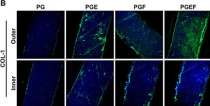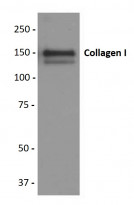ARG21965
anti-Collagen I antibody, pre-adsorbed
anti-Collagen I antibody, pre-adsorbed for Electron microscopy,ELISA,FLISA,Flow cytometry,ICC/IF,IHC-Formalin-fixed paraffin-embedded sections,IHC-Frozen sections,Immunoprecipitation,Western blot and Bovine,Cat,Chicken,Dog,Elephant,Guinea pig,Hamster,Human,Mouse,Pig,Rabbit,Rat,Sheep
Overview
| Product Description | Goat Polyclonal antibody recognizes Collagen I |
|---|---|
| Tested Reactivity | Hu, Ms, Rat, Bov, Cat, Chk, Dog, Elp, Gpig, Hm, Pig, Rb, Sheep |
| Tested Application | ELISA, EM, FACS, FLISA, ICC/IF, IHC-Fr, IHC-P, IP, WB |
| Specificity | The antibody reacts with conformational determinants on type I collagen. The antibody is pre-adsorbed with Collagen types II, III, IV, V and VI, so the antibody may not react with Collagen types II, III, IV, V and VI. |
| Host | Goat |
| Clonality | Polyclonal |
| Isotype | IgG |
| Target Name | Collagen I |
| Antigen Species | Human |
| Immunogen | Human Type I Collagen |
| Conjugation | Un-conjugated |
| Alternate Names | collagen type I alpha 1 chain; OI1; OI2; OI3; OI4; EDSC; Collagen alpha-1(I) chain; Alpha-1 type I collagen; Collagen type I alpha 2 chain; Collagen alpha-2(I) chain |
Application Instructions
| Pre Adsorbed | Collagen types II, III, IV, V and VI. | ||||||||||||||||||||
|---|---|---|---|---|---|---|---|---|---|---|---|---|---|---|---|---|---|---|---|---|---|
| Application Suggestion |
|
||||||||||||||||||||
| Application Note | WB: The antibody reacts with native and denature form of Collagen I protein. IHC-P: Antigen retrieval: select one of below: 1. Digestion with 0.1% pepsin from porcine gastric mucosa 3200–4500 units per mg (Sigma, Vienna, Austria) in 0.5 M acetic acid for 2 h at 37°C. 2. Microwave for 4 X 5 min at 800W in 0.01 M Sodium citrate buffer (pH 6.0). * The dilutions indicate recommended starting dilutions and the optimal dilutions or concentrations should be determined by the scientist. |
||||||||||||||||||||
| Observed Size | ~120-190 kDa (depending on the sample types) |
Properties
| Form | Liquid |
|---|---|
| Purification | Affinity purification with immunogen. |
| Buffer | BBS (pH 8.2) |
| Concentration | 0.4 mg/ml |
| Storage Instruction | For continuous use, store undiluted antibody at 2-8°C for up to a week. For long-term storage, aliquot and store at -20°C. Storage in frost free freezers is not recommended. Avoid repeated freeze/thaw cycles. Suggest spin the vial prior to opening. The antibody solution should be gently mixed before use. |
| Note | For laboratory research only, not for drug, diagnostic or other use. |
Bioinformation
| Gene Symbol | COL1A1; COL1A2 |
|---|---|
| Gene Full Name | collagen, type I |
| Background | Collagen type I is a fibril-forming collagen found in most connective tissues and is abundant in bone, cornea, dermis and tendon. Mutations in this gene are associated with osteogenesis imperfecta types I-IV, Ehlers-Danlos syndrome type VIIA, Ehlers-Danlos syndrome Classical type, Caffey Disease and idiopathic osteoporosis. Reciprocal translocations between chromosomes 17 and 22, where this gene and the gene for platelet-derived growth factor beta are located, are associated with a particular type of skin tumor called dermatofibrosarcoma protuberans, resulting from unregulated expression of the growth factor. Two transcripts, resulting from the use of alternate polyadenylation signals, have been identified for this gene. [provided by R. Dalgleish, Feb 2008] |
| Function | Type I collagen is a member of group I collagen (fibrillar forming collagen). [UniProt] |
| Highlight | Related Antibody Duos and Panels: ARG30346 Myofibroblast / Fibrosis Antibody Panel Related products: Collagen I antibodies; Collagen I ELISA Kits; Collagen I Duos / Panels; Anti-Goat IgG secondary antibodies; Related news: Collagen I antibody for studying rabbit bone differentiation New antibody panels for Myofibroblasts and CAFs |
| Calculated MW | COL1A1: 139 kDa COL1A2: 129 kDa |
| PTM | Proline residues at the third position of the tripeptide repeating unit (G-X-P) are hydroxylated in some or all of the chains. Proline residues at the second position of the tripeptide repeating unit (G-P-X) are hydroxylated in some of the chains. O-linked glycan consists of a Glc-Gal disaccharide bound to the oxygen atom of a post-translationally added hydroxyl group. |
Images (7) Click the Picture to Zoom In
-
ARG21965 anti-Collagen I antibody, pre-adsorbed IHC-P image
Immunohistochemistry: Rabbit osteochondral stained with ARG21965 anti-Collagen I antibody, pre-adsorbed at 1:100 dilution.
From Wenli Dai et al. Enhanced osteochondral repair with hyaline cartilage formation using an extracellular matrix-inspired natural scaffold (2023), doi: 10.1016/j.scib.2023.07.050, Fig. 7a.
-
ARG21965 anti-Collagen I antibody, pre-adsorbed ICC/IF image
Immunofluorescence: Rabbit synovium-derived mesenchymal stem cell stained with ARG21965 anti-Collagen I antibody, pre-adsorbed at 1:1000 dilution.
From Zong Li e et al. Chemical Engineering Journal, (2023), doi: 10.1016/j.cej.2023.145209, Fig. 4B.
-
ARG21965 anti-Collagen I antibody, pre-adsorbed IHC-P image
Immunohistochemistry: Canine aorta mesothelial stained with ARG21965 anti-Collagen I antibody, pre-adsorbed at 1:500 dilution.
From Masakazu Shimada et al. PLoS One. (2022), doi: 35061786, Fig. 1.
-
ARG21965 anti-Collagen I antibody, pre-adsorbed ICC/IF image
Immunofluorescence: Human fibroblasts were stained with ARG21965 anti-Collagen I antibody (pre-adsorbed).
-
ARG21965 anti-Collagen I antibody, pre-adsorbed IHC-Fr image
Immunohistochemistry: Frozen MC4R-KO Mouse liver section was stained with ARG21965 anti-Collagen I antibody (pre-adsorbed), anti-F4/80 antibody followed by secondary antibodies and DAPI.
-
ARG21965 anti-Collagen I antibody, pre-adsorbed WB image
Western blot: Purified Human Type I Collagen stained with ARG21965 anti-Collagen I antibody (pre-adsorbed).
-
ARG21965 anti-Collagen I antibody, pre-adsorbed IHC-P image
Immunohistochemistry: Paraffin embedded Rat kidney section post uninephrectomy was stained with ARG21965 anti-Collagen I antibody (pre-adsorbed) followed by a secondary antibody and AEC.
Specific References














